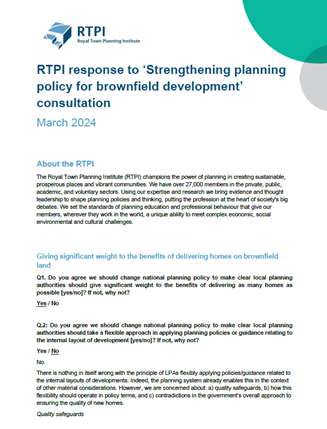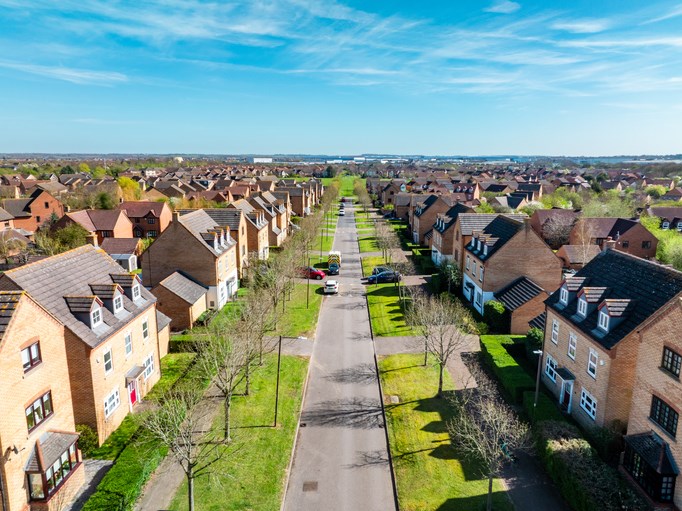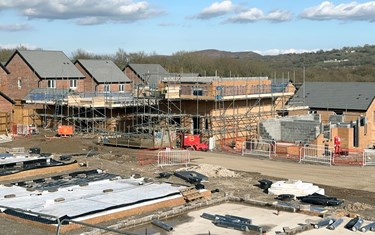 About the RTPI
About the RTPI
The Royal Town Planning Institute (RTPI) champions the power of planning in creating sustainable, prosperous places and vibrant communities. We have over 27,000 members in the private, public, academic, and voluntary sectors. Using our expertise and research we bring evidence and thought leadership to shape planning policies and thinking, putting the profession at the heart of society's big debates. We set the standards of planning education and professional behaviour that give our members, wherever they work in the world, a unique ability to meet complex economic, social environmental and cultural challenges.
Giving significant weight to the benefits of delivering homes on brownfield land
Q1. Do you agree we should change national planning policy to make clear local planning authorities should give significant weight to the benefits of delivering as many homes as possible [yes/no]? If not, why not?
Yes / No
Q.2: Do you agree we should change national planning policy to make clear local planning authorities should take a flexible approach in applying planning policies or guidance relating to the internal layout of development [yes/no]? If not, why not?
Yes / No
No.
There is nothing in itself wrong with the principle of LPAs flexibly applying policies/guidance related to the internal layouts of developments. Indeed, the planning system already enables this in the context of other material considerations. However, we are concerned about: a) quality safeguards, b) how this flexibility should operate in policy terms, and c) contradictions in the government’s overall approach to ensuring the quality of new homes.
Quality safeguards
As noted above, the planning system already enables LPAs to take a flexible approach to the application of planning policies/guidance. However, we would be concerned if these changes resulted in decision makers not giving enough weight to residents’ wellbeing or the overall quality of new developments. As such:
- National policy should continue to expect that new development provides acceptable living standards; and
- Local authorities should continue to exercise discretion to ensure that new developments are of an acceptable standard.
RTPI-supported research suggests that there are already widespread concerns about the quality of new homes being delivered across the UK (‘Delivering Design Value: the housing design quality conundrum’, CaCHE, 2020’).
Ensuring flexibility
Directing LPAs to apply local policy/guidance flexibly makes sense where that policy is already fixed and the local plan is unlikely to change in the near-term (as we stated above, the planning system already enables local decision makers to do this where appropriate).
However, this is not the case for those LPAs that are updating or developing new policy/guidance on the subject. It would make more sense for national policy to direct these LPAs to develop policy/guidance on internal layouts which is itself flexible (rather than applying firm policy in a flexible way). This would reduce uncertainty at the point of deciding applications.
The government’s direction of travel on standards for new homes
A more flexible approach to the application of internal standards for new homes appears to contradict the government’s proposed direction of travel for building regulations (as laid out in the Future Homes and Buildings Standards: 2023 consultation).
Perhaps the most significant source of uncertainty and slow-down in the delivery of new homes on urban brownfield sites is changes to fire safety regulations, and these proposals do not address those issues.
Q3. If we were to make the change set out in question 2, do you agree this change should only apply to local policies or guidance concerned with the internal layout of developments [yes/no]? If not, what else should we consider?
Yes / No
Q4. In addition to the challenges outlined in paragraph 13, are there any other planning barriers in relation to developing on brownfield land?
Yes.
In addition to the challenges outlined in paragraph 13 (the variety and complexity of sites, and the additional cost of bringing forward schemes due to issues like land assembly, and remedial works), developers also face barriers related to:
Skills – Site assembly, the use of CPO, and working with multiple landowners and other partners can be highly complex in relation to developing brownfield land. It requires specialist skills which many local authority officers lack.
Policy constraints – For example, brownfield sites in many urban areas (including those subject to the urban uplift, such as Leicester and Liverpool) are located within historic urban centres which have significant heritage value.
Flooding – Because of climate change many urban areas are increasingly at risk of flooding which, in conjunction with these other challenges, could render them permanently unviable without intervention.
Existing uses – The existing use value of brownfield land suitable for residential development can be high. When considered alongside the fact that residential development on brownfield land can require expensive decontamination and contributions towards infrastructure, there can be little financial incentive for residential development to be taken forwards on some sites.
Biodiversity Net Gain (BNG) – This represents an additional hurdle for developers. As we argued in our April 2022 response to the Defra consultation ‘Biodiversity Net Gain Regulations and Implementation’:
“The achievement of much urban regeneration in areas of focus for levelling up takes place on derelict or vacant land. In some cases, such land may have acquired biodiversity value as a result of having been in that state for so long. Much land of this kind is of negative land value… …We consider that to impose BNG on vacant or derelict land in areas of precarious development viability would be effectively shooting regeneration policy in the foot. Furthermore, the continued pressure to meet housing targets, which have been especially and recently increased in the 20 key cities, means that regeneration schemes have taken on an extra importance. Upsetting the viability of derelict or vacant sites in levelling up priority areas would therefore also risk of increasing greenfield development to make up the difference.”
Brownfield sites are often colonised by open mosaic habitats (a highly distinct ‘priority habitat’), and BNG trading rules for this type of habitat can be very difficult to accommodate on-site or offset. When coupled with the viability challenges brownfield sites often face, developers may find that offsetting payments to maximise development on such a site are challenging but non-negotiable. The impact may be that developers are forced to reduce the amount of development on brownfield sites in order to deliver a BNG net gain.
Difficulty in delivering long-term phased consents – The ‘Hillside’ decision (‘Hillside Parks Ltd v Snowdonia National Park Authority [2022] UKSC 30’ - see Turley (2022)) means that ‘drop-in’ applications (which are used to make changes to existing permissions on individual parcels of land within a wider development site, without revisiting the principles underlying the original consent) can no longer be relied upon to alter proposed developments once consent has been granted.
This is a particular concern for brownfield development, which is typically more complex and uncertain than greenfield, and is therefore more likely to require altered permissions further down the line. As such, more complex brownfield developments may require the submission of new site-wide permissions.
Q5. How else could national planning policy better support development on brownfield land, and ensure that it is well served by public transport, is resilient to climate impacts, and creates healthy, liveable and sustainable communities?
There are a range of ways in which national planning policy could better support development on brownfield land. Below we identify: a) measures which could be taken relatively quickly and within the current/proposed policy framework, and b) changes to the wider national policy framework and the balance of national policy.
Shorter-term measures within the current framework
Prioritising brownfield development in Homes England funding: Brownfield sites often remain undeveloped, despite the ambitions of government and local leaders, because they are by their nature more expensive and complex than greenfield sites. One of the most effective and swiftest interventions that government could make is therefore to further scale up targeted Homes England funding for the remediation and development of brownfield sites.
Reviewing and updating brownfield land registers: To maximise brownfield capacity, DLUHC should fund LPAs across England to review and update their brownfield land registers to identify additional capacity within authority areas (in conjunction with local plan progression). There is evidence that many registers are out of date or contain poor-quality data (see ‘Banking on Brownfield’ by Lichfields (2022)).
Applying changes to the Housing Delivery Test threshold beyond authorities subject to the urban uplift: The proposals associated with question nine (concerning the Housing Delivery Test) could be applied more widely for the following reasons:
- It would maximise the number of developable sites that fall within the scope of this new threshold and reduce the overall development burden on greenfield sites across the country;
- Similarly, many more areas would benefit from the advantages that denser brownfield development may bring (for example, increased footfall, walkable neighbourhoods, protected rural environments, maximising the use of existing infrastructure, etc); and
- Functional city/urban areas and LPAs’ administrative areas often map onto each other poorly, with the former often comprising several different LPAs. The urban uplift is applied to only those LPAs with the highest population within each of the 20 most populous defined urban areas outside of London, but other parts of those urban areas may host the best opportunities for brownfield development. There seems little sense to apply these changes to Manchester City but not Salford, for example.
Wider changes to national planning policy
Strategic planning: The implementation of strategic planning (i.e. spatial planning at a larger-than-local scale) can overcome several of the challenges we identified in question four. It would enable different types of new homes to be built on the brownfield sites most appropriate for them across an entire urban area. Being able to better ‘match’ developments with local needs and sites in this way would serve local housing needs more effectively.
Making planning decisions at the level of travel-to-work areas also enables new developments to be more effectively linked to employment and public services. This would be supported by much closer alignment of local plans and local transport plans, which are often disjointed.
Ensuring that new homes and places are of a good standard: While we understand the government’s desire to maximise brownfield development and enable it through greater flexibility in the application of local policy, quantity should not be pursued at the cost of all else. The quality of homes can have a profound impact on residents’ wellbeing (TCPA, 2024) and we are not sure to what extent the language used by the NPPF ('…as long as the resulting scheme would provide acceptable living standard’) provides a strong enough safeguard against the development of substandard housing.
Indeed, there is evidence that the huge pressure already placed on councils by the government to meet housing targets may be leading to suboptimal outcomes, both in terms of quality of homes (‘Delivering Design Value: the housing design quality conundrum’, CaCHE, 2020’) and their location (RTPI, 2021).
Going beyond internal standards, individuals often choose to live in urban areas because of the access to services and amenities. If the local plan policies that support these things are undermined in pursuit of stricter housing targets for brownfield sites, and this results in poor-quality places, the overall outcome may be self-defeating: both local support for development on, and the desirability of, brownfield developments could be undermined.
Given the concerns laid out above, the government should monitor the impact of these proposed changes on the quality of new homes, and adjust policy if there is any evidence of them compromising residents’ living standards and the quality of the wider built environment. If this is a concern, national policy should more firmly prioritise these issues.
Ensuring that a focus on meeting brownfield housing targets does not undermine the delivery of other critically important types of development: Similarly, there is a risk that in an effort to meet these new brownfield housing targets, LPAs do not sufficiently plan for developments of other crucially important land uses on brownfield sites.
There is already evidence of this happening. Research titled ‘Banking on Brownfield’ by Lichfields (2022) has found that industrial and office uses can be displaced to sub-optimal sites by residential development which may be more appropriately delivered elsewhere:
“…the opportunity cost of prioritising brownfield land for housing rather than employment is significant in pricing out industrial and office development to potentially sub-optimal locations. Redevelopment for many employment uses requires less remediation work than for residential land. Additionally, the greater the premium for residential over industrial land, the more significant the challenges are to effectively sustain both jobs growth and housing growth.”
This is not a zero sum-game in which either new homes or new services (shops, logistics, health, etc) and employment sites are delivered. To be viable, new and existing housing developments need access to both.
National planning policy and guidance should make clear that while delivering new homes on brownfield sites is a priority, LPAs should continue to weigh up local needs and opportunities in how they weigh up site allocations, and plan for high-quality places.
With this in mind, government should monitor the impact of the changes proposed in this consultation on the delivery of commercial, logistical, and industrial development, and adjust policy if there is any evidence of delivery of those priorities being undermined.
Q6. How could national planning policy better support brownfield development on small sites?
Reviewing and updating the data contained in brownfield registers would be of particular benefit for small sites: both LPAs and SMEs can find it difficult to identify viable and available small sites, and the former can then find it harder to include such sites in their brownfield registers.
As we outlined in response to question five, DLUHC should fund LPAs across England to review and re-publish their brownfield land registers to identify additional capacity within their areas. There is evidence that many registers are out of date or contain poor-quality data (see Lichfields (2022).
Applying the presumption in favour of sustainable development to brownfield applications in major towns and cities
Q7. Do you agree we should make a change to the Housing Delivery Test threshold for the application of the Presumption in Favour of Sustainable Development on previously developed land [yes/no]?
Yes / No
Q8. Do you agree the threshold should be set at 95% [yes/no]? Please explain your answer.
Yes / No
On balance, yes.
Q9. Do you agree the change to the Housing Delivery Test threshold should apply to authorities subject to the urban uplift only [yes/no]? If not, where do you think the change should apply?
Yes / No
No.
If the government’s policy ambition is to deliver new homes as far as possible on brownfield land, it makes little sense to only apply the HDT to authorities that are subject to the urban uplift (see our response to question five).
It should instead apply to all brownfield land within LPAs’ defined development limits (it is important to note that not all brownfield sites are in sustainable or desirable locations, with many in poorly connected or unsustainable places) in all authorities across England. There are several reasons for this, including:
- It would maximise the number of developable sites that fall within the scope of this new threshold and reduce the overall development burden on greenfield sites across the country.
- Many of the benefits which the twenty most populous urban areas would receive from more intensive brownfield development – increased footfall, walkable neighbourhoods, protected rural environments, maximising the use of existing infrastructure, etc – apply to many local authorities outside of this list.
- Actual urban areas and LPAs’ administrative areas often map onto each other poorly. This means that, in functional cities like Liverpool City Region or Greater Manchester, the proposed changes to the HDT only apply to one LPA within their area. This could be despite the best opportunities for brownfield development being elsewhere within that same urban area. This issue emphasises the need to plan for new housing at the strategic level (as we highlighted in response to question five).
In addition, the proposed approach has the potential to result in considerable complexity, as some LPAs would need to produce different HDT calculations in their urban and non-urban areas.
Q10. Do you agree this should only apply to previously developed land within those authorities subject to the urban uplift [yes/no]?
Yes / No
Q11. Do you agree with the proposal to keep the existing consequences of the Housing Delivery Test the same [yes/no]? If not, why not?
Yes / No
Q12. For the purposes of Housing Delivery Test, the cities and urban centres uplift within the standard method will only apply from the 2022/23 monitoring year (from the 2023 Housing Delivery Test measurement). We therefore propose to make a change to the policy to align with the publication of the Housing Delivery Test 2023 results. Do you agree [yes/no]? If not, why not?
Yes / No
Reviewing the threshold for referral of applications to the Mayor of London
Q13. Do you think the current threshold of 150 residential units for referral of a planning application of potential strategic importance to the Mayor of London is the right level [yes/no]?
Yes / No
Q14. If no, what would you set as the new threshold? Please explain your answer.
A threshold of 500 is more appropriate, given that the London Boroughs normally engage with the GLA on developments of this size in relation to height.
This range would set the right balance between enabling the GLA to push up densities at lower levels, and allowing boroughs flexibility.
It is important to note that the GLA can play a proactive role in encouraging development at higher densities where this would be appropriate.
Public Sector Equality Duty
Q15. We continue to keep the impacts of these proposals under review and would be grateful for your comments on any potential impacts that might arise under the Public Sector Equality Duty as a result of the proposals in this document.
In response to question five we advised that government should monitor the implementation of these proposals to ensure that they do not result in the delivery of new homes on brownfield sites at the cost of all else, including other crucial urban land uses and the quality of the new homes. The quality of new homes can be of particular concern for groups with protected characteristics: older people and disabled people may require higher accessibility and space standards than those guaranteed through building regulations, but these can be more difficult to deliver on brownfield sites, where viability is more of a challenge. There is therefore a risk that some LPAs’ efforts to meet these targets for brownfield development undermine the delivery of homes suitable for older or disabled people across the LPA area.
LPAs should continue to plan to identify and meet these needs. This may require development on greenfield sites, where viability can be less challenging.


